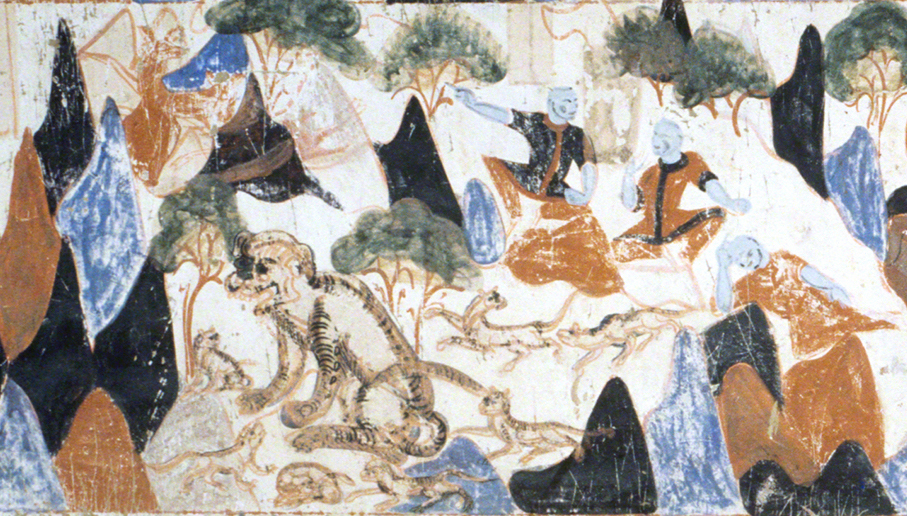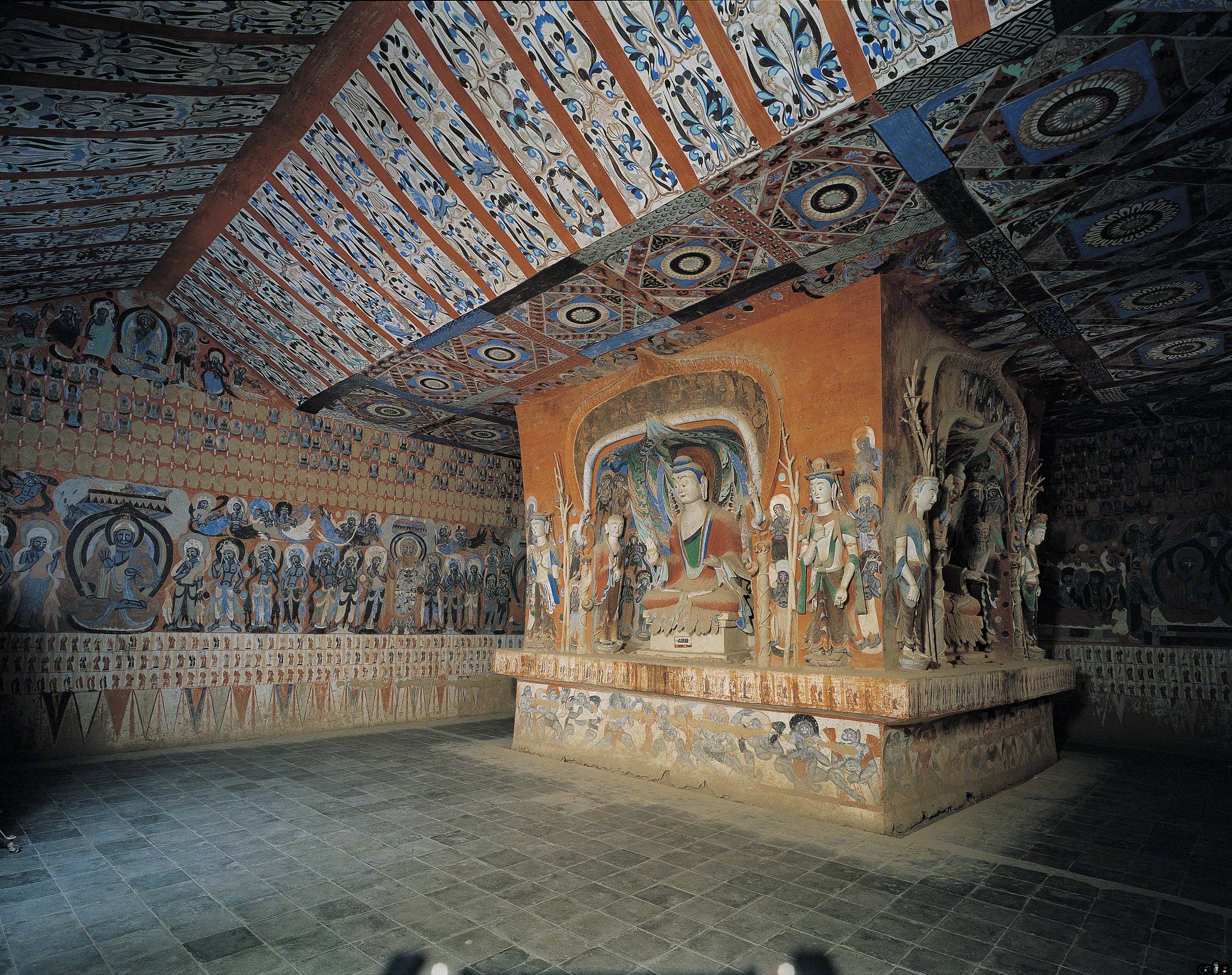The complete Prince Mahasattva jataka tale mural. Mogao Cave 428. Northern Zhou, 557-581 CE. Dunhuang. Image courtesy of the Dunhuang Academy.
Before he was born as Prince Siddhartha Gautama, the Buddha’s soul accumulated much virtue from his many previous lifetimes as various selfless beings.
Jataka tales are stories about the past lives of the Buddha. These stories tell of the Buddha's previous incarnations and the ways in which he accumulated his good karma through sacrifice.
This Dunhuang mural depicts a famous Jataka tale about Prince Mahasattva. Painted on the eastern wall of Mogao Cave 428 is a mural of the entire Jataka tale in three registers.
Detail of the three princes paying their respects to the king and queen before they leave for the forest. First register, right section. Mogao Cave 428. Northern Zhou, 557-581 CE. Dunhuang. Image courtesy of the Dunhuang Academy.
The mural begins on the right-hand side of the first register. Three young men kneel before a blue pagoda with their hands pressed together in the form of genuflection. Two regal figures sit inside the blue pagoda; they are presumably the king and the queen. They wave farewell to the three young men, who are presumably their sons.
In the next few scenes, the three brothers head off into the forest to go on a hunt. Deer and tigers populate the forest while trees and mountain ranges frame each scene. The undulating, multi-colored mountains are scaled to be smaller than the trees, animals, and human figures.
Detail of the three princes hunting in the forest. First register, middle section. Mogao Cave 428. Northern Zhou, 557-581 CE. Dunhuang. Image courtesy of the Dunhuang Academy.
The story continues on the second register, this time beginning on the left-hand side. The three brothers continue further into the forest when they descend from their horses to take a rest at the base of some mountains.
During their rest, the brothers spot a tigress with seven baby cubs. The tigress is depicted with her mouth open and painted in dreary shades with drooping limbs. She stares at baby cubs who prance around her feet. She looks ready to eat her own children.
Detail of the starving tigress and her baby cubs. Second register, middle-left section. Mogao Cave 428. Northern Zhou, 557-581 CE. Dunhuang. Image courtesy of the Dunhuang Academy.
The brothers convene to discuss the matter of the tigress. Not wanting to watch a mother devour her own children, the brothers resolve to help her find food. However, there does not appear to be any food nearby.
Prince Mahasattva suddenly comes up with an idea. He keeps it to himself and tells his two brothers to leave the forest to find some food while he stays behind to watch over the tigers.
After his brothers leave, Prince Mahasattva strips off his clothes and lies down in front of the tigress, offering himself to the tigress. He decides to offer himself as food for the tigress so that she wouldn't have to eat her own children.
The tigress sniffs at his body but makes no move to harm him even though she is starving.
When we offer help to someone and they are unable to accept what is offered, it's a chance for us to feel good about having attempted goodness without losing anything. We can think to ourselves, well, we tried to help. In the case of Prince Mahasattva, he understood that good intentions alone would not save a life. It would take determined and complete self-sacrifice to save the tigers.
Realizing that the tigers will not eat him alive, Prince Mahasattva climbs to the edge of a cliff, cuts open his neck and throws himself off the ledge. With his neck bleeding profusely, his body drops in front of the tigress and her cubs.
At Prince Mahasattva's second attempt to offer his body, the tigers devour him as nourishment.
Detail of the Prince Mahasattva's sacrifices to the tigers. Second register, right section. Mogao Cave 428. Northern Zhou, 557-581 CE. Dunhuang. Image courtesy of the Dunhuang Academy.
Snaking across and down the three registers, the story continues on the third register by beginning on the right-hand side again. Prince Mahasattva's brothers return and they understand what happened in their absence when they see the bones left behind by the tigress and her cubs.
The brothers' bodies contort across the scene in shock, anguish, and grief in reaction to the death of their third sibling.
Detail of the grieving brothers and their return to the palace. Third register. Mogao Cave 428. Northern Zhou, 557-581 CE. Dunhuang. Image courtesy of the Dunhuang Academy.
The two brothers practically fly back to the palace on their horses to tell the king about what happened to Prince Mahasattva.
The story actually ends on the topmost right corner of this image, returning to the place where the two princes found their brother's corpse. After reporting to the king, the family builds a stupa over Prince Mahasattva's bones and hair to commemorate his selfless actions.
Detail of the brothers building a stupa over Prince Mahasattva's remains. Third register. Mogao Cave 428. Northern Zhou, 557-581 CE. Dunhuang. Image courtesy of the Dunhuang Academy.
The Stupa
A stupa is a sacred Buddhist architectural structure built as a shrine over relics or simply as a place for spiritual meditation. A stupa is a place imbued with strong Buddhist power. People make pilgrimages to famous stupas such as the Boudhanath stupa in Nepal.
Worshippers pray at stupas by circumambulating clockwise around the monument.
Pilgrims circumambulating the Boudhanath stupa. 14th century. Kathmandu, Nepal. Image by Alina Chan from Wiki Commons.
Many of the Mogao caves at Dunhuang have central pillars that take after the stupa form.
Scholars have theorized that worshippers could have circumambulated these central pillars inside the Mogao caves at Dunhuang as one would do around stupas in the open air.
The central pillar in Mogao Cave 428. Northern Zhou dynasty. 557-581 CE. Dunhuang. Image courtesy of the Dunhuang Academy.
If you return to look at the complete image of this Jataka tale at the top of this post, you may notice that this Jataka tale stops abruptly in the middle of the third register. Two white and blue palaces formally frame the narrative painting of Prince Mahasattva like bookends.
The section below is the left corner of the bottommost register of the mural. These drawings depict two other tales.
Detail of the left side of the third register of the Mahasattva jataka painting. Mogao Cave 428. Northern Zhou, 557-581 CE. Dunhuang. Image courtesy of the Dunhuang Academy.
On the left is a scene based on a verse from chapter four of the Dhammapada, a volume known as a collection of the Buddha's sayings and teachings in Theravada Buddhism. The scene on the right depicts the tale of the seduction of the ascetic Ekaśṛṅga.
These are both very interesting stories that we will save for another post.
Further Reading
- Ancient: Stupa
- Google Arts & Culture: Jātaka of Prince Mahasattva
- Just Fun Facts: Interesting Facts about Boudhanath
- Lion's Roar: What is a Stupa?
- MonkeyTree: A Prince Gives His Life to a Tiger
- Quora: Why were stupa built?
__. 敦煌石窟內容总录. 敦煌研究院:文物出版社, 1996. Page 175.
Wu, Ming-Kuo. The Jataka Tales of the Mogao Caves, China in Anthropological Perspective. Washington State University (2008).










